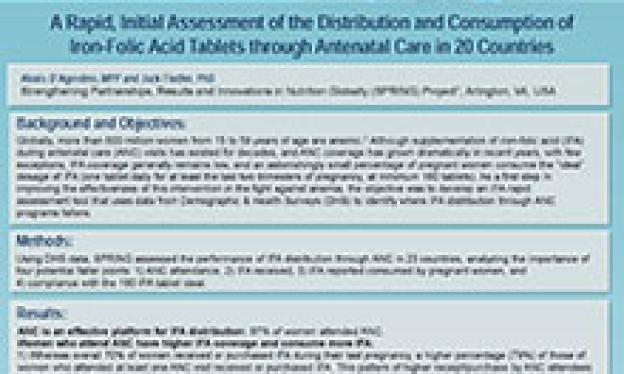Authors: D’Agostino A; Fiedler J; Nekatebeb H
Background and objectives: Globally, more than 600 million women from 15 to 59 years of age are anemic.2 Although supplementation of iron-folic acid (IFA) during antenatal care (ANC) visits has existed for decades, and ANC coverage has grown dramatically in recent years, with few exceptions, IFA coverage generally remains low, and an astonishingly small percentage of pregnant women consume the "ideal" dosage of IFA (one tablet daily for at least the last two trimesters of pregnancy, at minimum 180 tablets). As a first step in improving the effectiveness of this intervention in the fight against anemia, the objective was to develop an IFA rapid assessment tool that uses data from Demographic & Health Surveys (DHS) to identify where IFA distribution through ANC programs falters.
Methods: Using DHS data, SPRING assessed the performance of IFA distribution through ANC in 23 countries, analyzing the importance of four potential falter points: 1) ANC attendance, 2) IFA received, 3) IFA reported consumed by pregnant women, and 4) compliance with the 180 IFA tablet ideal.
Results: ANC is an effective platform for IFA distribution: 87% of women attended ANC. Women who attend ANC have higher IFA coverage and consume more IFA: 1) Whereas overall 70% of women received or purchased IFA during their last pregnancy, a higher percentage (79%) of those of women who attended at least one ANC visit received or purchased IFA. This pattern of higher receipt/purchase by ANC attendees holds across all 23 countries. 2) While 34% of all pregnant women do not take any IFA tablets, this percentage falls to 25% among women with any ANC visits.
Conclusions: Only 9% of pregnant women in the 23 study countries consumed the ideal of 180 tablets in their last pregnancy. Although the tool cannot identify the specific cause(s) of a system’s faltering performance, it identifies the point(s) at which the system is weak, which constitutes an essential, evidence-based, first step in improving the functioning of the system. The tool prioritizes follow-up activities to better understand the causes of the identified shortcomings.
